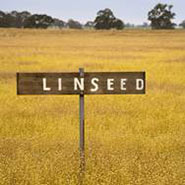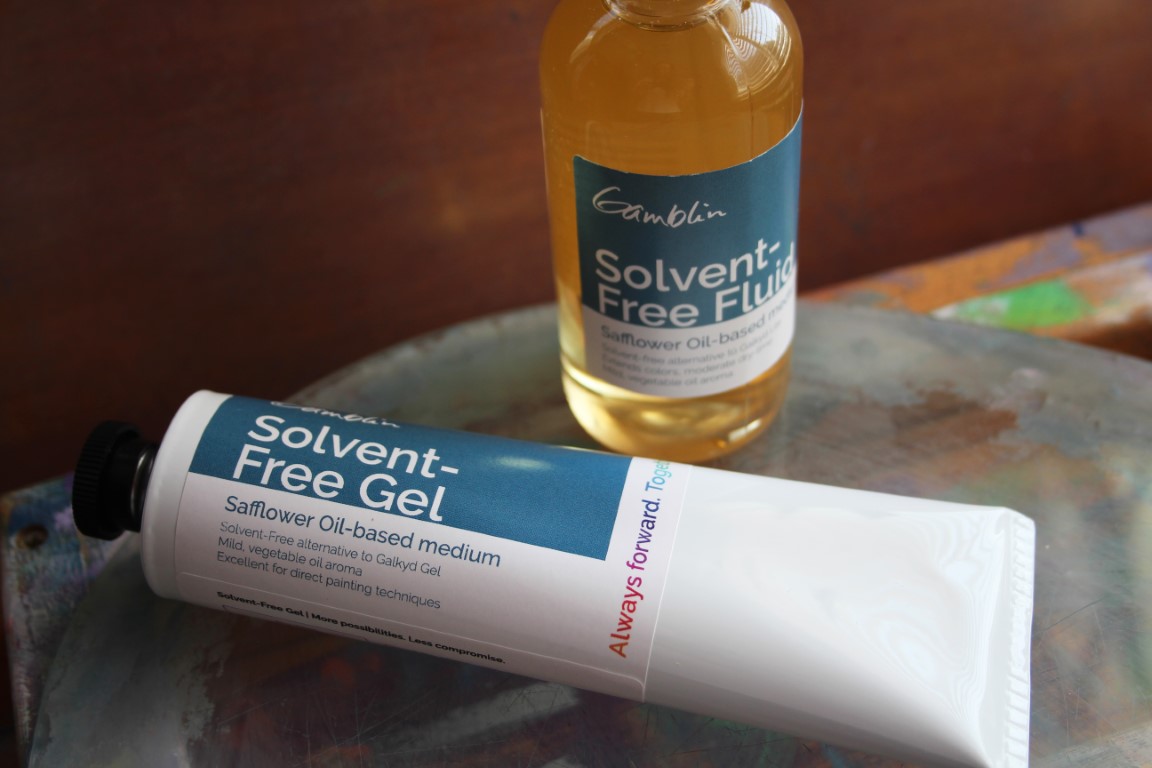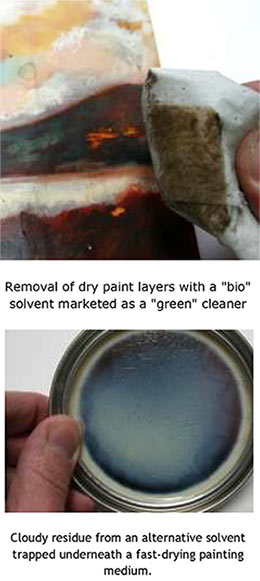
Field of Flax
Since our founding, Gamblin Artists Colors has handcrafted materials with the well-being of artists, their work and the environment in mind. We have a tradition of innovation and we are unwavering on some things. We will not compromise on color or artistic possibilities. This Studio Safety Guide is intended to help artists create without compromise in a safe studio environment.
Color
Linseed oil is pressed from the seeds of the flax plant. The flax plant has been the heart and soul of oil painting, giving us both the oil our colors are bound with and – from the stalks of the plant – the linen we paint on. Linseed oil naturally dries faster than other oils and retains greater strength and flexibility as it ages. We use safflower oil in some colors. Not only are both of these vegetable oils completely non-toxic, but they are also both used in moisturizers, cooking oils, food, and vitamins.
Linseed and safflower oils do not give off “fumes.” In fact, these oils take in oxygen as part of their drying process. Gamblin Artist’s Oil Colors* and Gamblin 1980 Oil Colors do not contain solvent, nor do they require any solvent for their use. Simply put, our oil colors have always been solvent-free. The pigments used in oil colors are the same pigments found in watercolors, acrylics, and pastels. Since we do not use any pigments based on lead, mercury, or arsenic, with very few exceptions our colors are completely non-toxic and do not require health labeling of any kind.
Acrylics, by contrast, are more complex formulas of plastic, water, pigment, ammonia, and other chemicals.
Artist’s materials should be used in the manner for which they are intended and, as part of that, artists should be sensible in the use and management of all materials in their studio. It is best not to eat, drink, or smoke while painting. Thoroughly wash your hands after your painting session, and before eating.
*Please note that our metallic colors (Pale Gold, Rich Gold, Copper, and Silver), contain a small amount of Gamsol in their alkyd resin binder and are therefore not solvent-free. These are the only exceptions.
Lead-based Pigments
A few artists continue to use lead white. Lead whites, in general, are characterized by a heavy texture, slightly warm in color and more opalescent than Titanium White. This quality makes it very valuable for figure painting.
Gamblin was the first to formulate Flake White Replacement. It has the working properties of lead white but is lead-free, so it is non-toxic.
Similarly, we developed Naples Yellow – a pale, opaque, and earthy yellow that is true to historic working properties of the color but is completely lead-free.
Cadmium and Cobalt colors
Gamblin Artist’s Oil colors are completely non-toxic when used as recommended.
There is no cadmium dust or “fumes” that come off paints in the tube, on your palette or in your painting.
Cadmium presents a health concern if they are inhaled. We recommend you use NIOSH dust respirator if you sand surfaces made with a high percentage of Cadmium colors or work with cadmium in dry pigment form.
The cadmium pigment sources we work with have developed cadmium pigments that are relatively insoluble in the human digestive system. They have been so successful that Gamblin cadmium colors DO NOT REQUIRE a Federal ASTM health-warning label for skin contact or ingestion. If other brands carry a warning label for these exposures their supplier’s pigments cannot meet these standards.
Over thirty years ago when we first started making oil colors, the best cadmium pigments available were still much more soluble in the human system than they are now. Now the cadmium pigments we work with are largely insoluble through ingestion. Having said that, we don’t recommend eating paint.
The only color in our line that carries a federal health warning label is Cobalt Violet. This pigment is a compound of cobalt and phosphate. If you eat Cobalt Violet, you can expect some cobalt to be retained by your body.
Cobalt Blue is a compound of cobalt and aluminum. Cobalt Green is a compound of cobalt and zinc. Oil colors made from these compounds do not carry health-warning labels because the cobalt cannot be readily absorbed into the body. Just like when using Cadmiums, artists should not inhale the dust from cobalt pigments when sanding dry paint layers and artists should not eat their paints.
There is no need to work with gloves when oil painting with cadmium or cobalt colors – or with any of our colors for that matter. If you get oil color on your hands, simply wash them with soap and water.
Painting Mediums
Painters use painting mediums to change the viscosity, texture, dry time, gloss level, and increase the transparency of oil colors. Our approach is to offer artists contemporary oil painting mediums that are true to historic working properties, yet safer and more permanent.
Traditional versus Contemporary Painting Mediums
Gamblin mediums are formulated with a soy-based alkyd resin, proven to retain its flexibility much better than damar-based mediums. Since the alkyd resin is essentially a polymerized oil, it is compatible with the linseed oil binder of colors. And significant to this conversation, our resin allows us to create mediums with the mildest form of odorless mineral spirits: Gamblin Gamsol.
For painters who wish to paint in oils without the use of any solvents, Gamblin Solvent-Free Gel and Solvent-Free Fluid painting mediums give painters more possibilities with less compromise. Both mediums are made with safflower oil and soy-based alkyd resin with no solvent, not even Gamsol. Solvent-Free Gel and Solvent-Free Fluid moderately speed drying and, along with Gamblin Safflower Oil for brush cleaning, support painters working solvent-free.
Artists Solvents

Gamsol versus other solvents
Not all solvents used in oil painting are created equal. Gamsol allows painters to work in traditional and contemporary techniques without compromising artistic possibilities, permanence or your well-being. Gamsol is also reusable and non-toxic when used as recommended.
Most solvents available to artists are produced for the industrial paint industry where solvent strength and low cost take priority over safety. Gamsol is different. It comes from a family of materials used in products that come into more intimate contact with the body such as cosmetics, hand cleaners, and cleaning food service equipment.
For an artist, there are a number of factors to consider when judging a solvent’s safety. Aromatic solvents are the most harmful type of mineral spirits. Gamsol is an odorless mineral spirit which has all of the aromatic solvents refined out of it – less than .005% remains. In addition, Gamsol has a slow evaporation rate, a high flash point, and is not absorbed through healthy skin.
These factors have led to Gamsol being the Standard for Studio Safety, and the solvent of choice among artists and instructors in classrooms and home studios.
Definition of an Artist’s Solvent
The Artist’s Handbook of Materials and Techniques by Ralph Mayer and The Painter’s Handbook by Mark Gottsegen are the two definitive books on painting materials published in America. They both define the working properties of an ideal artist’s solvent the same way.
An artist’s solvent should:
- Evaporate completely
- Evaporate at a uniform rate
- Have no effect on dried paint layers
- Be chemically inert to the materials with which it is used (i.e. have no chemical reaction)
- Mix completely with the materials with which it is used
- Have no toxic vapors
- Evaporate entirely from the dried paint film within a reasonable amount of time
Many solvents on the market satisfy some of these requirements. Gamsol meets all of these requirements when used as recommended.
Gamblin Gamsol odorless mineral spirits balance both performance and safety like no other artist’s solvent on the market.
Recommended uses for Gamsol
Thinning oil colors
Gamsol beautifully thins oil colors. A little goes a long way; oil colors relax immediately when a little Gamsol is added. Since Gamsol evaporates completely, no sticky residue is left behind that could compromise the drying or strength of paint layers.
Modifying painting mediums
Gamblin Galkyd painting mediums are formulated with Gamsol, so they readily accept Gamsol as a solvent. Gamsol should not be added to traditional painting mediums containing dammar, copal, mastic resins; they require strong solvents such as turpentine. Adding Gamsol to oil painting mediums is an effective means of modifying the oil (“fat”) content of these materials to allow artists to explore indirect/glazing techniques.
Studio clean-up
Gamsol is great for general studio clean-up of brushes, palettes, palette knives and other tools. As a brush cleaner, it effectively removes oil colors from brushes to allow for clean mixing and application of color. Using Gamsol for brush-cleaning during and after the painting session eliminates the risk of slow or non-drying oil from interfering with paint layers.
Solvent-Free Painting
For painters who wish to paint in oils without the use of any solvents, we recommend Gamblin Solvent-Free Gel or Solvent-Free Fluid painting mediums. Both mediums will increase the flow of oil colors and moderately speed drying. Solvent-Free Gel retains marks and texture more readily than our Solvent-Free Fluid medium. Adding small amounts of either Safflower Oil or Refined Linseed Oil will increase the flow of oil colors, but will slow drying.

For brush clean-up during your painting session, first, wipe excess paint from brushes with a rag. Then dip your brush in a container of Gamblin Safflower Oil. Next, wipe the safflower oil and any remaining pigment from your brush with a rag and continue painting. After your painting session, brushes can be further cleaned using Gamsol and/or soap and water.
To ensure proper drying of paint layers, Solvent-Free painting mediums and drying oils should be used in moderation with oil colors. No more than 25% by volume. To avoid wrinkling, apply mixtures of Solvent-Free materials and oil colors thinly. Using large amounts of any oil or a solvent-free medium can cause wrinkling (too fat), increase yellowing and/or excessively slow drying.
For underpainting, we recommend adding Gamsol to Solvent-Free painting mediums. For glazing techniques, we recommend our contemporary Galkyd family of painting mediums.
Use of “Green” Solvents and Cleaners in Oil Painting
 With extra care and effort, artists can make almost any type of soap or cleaner work for studio clean-up. Some products consume a lot of water, some are much harder on brushes than others and some leave sticky residues behind. But most all do a decent job.
With extra care and effort, artists can make almost any type of soap or cleaner work for studio clean-up. Some products consume a lot of water, some are much harder on brushes than others and some leave sticky residues behind. But most all do a decent job.
For modifying oil colors and mediums, however, alternatives to true artist’s solvents – even in very small amounts – can create major and unpredictable problems.
In sticking with the criteria for an artist’s solvent, a thinner should not dissolve dry paint layers, should evaporate 100% without leaving a residue in paint layers and should evaporate in a timeframe that does not interfere with the performance of the paint layer.
Gamblin Galkyd painting mediums, Cold Wax, Gamvar Picture Varnish, and Ground are all formulated with Gamsol. For this reason, we only recommend Gamsol for thinning these materials.
Managing Materials – Best Practices
After choosing safer materials creating a Safe Studio and working safely is easy. As a start, artist’s materials should be used in the matter for which they are intended.
Ventilation
According to the recommendation of environmental hygienists, studio air should be changed ten times per hour. Normal air circulation in most buildings and homes will allow for adequate air exchange using Gamblin oil painting materials. Increased air exchange can be attained by opening the windows and by inserting a fan in one window to blow air out.
Disposal of Rags
Caution! Oily rags may spontaneously combust. Do not leave oily rags crumpled in your studio. After use put rags in water or hang dry before discarding.
Many oil painters don’t use enough paint rags or paper towels in a studio session to be concerned about them building up. Simply hang up one or two used paint rags when done painting for the day allowing them to dry out. Once dry, paint rags can be reused or safely disposed of in household garbage. Individual paint rags, even saturated with oil and Gamsol, will not spontaneously combust when laid out or hung up alone to dry.
Working with Gamsol
Use only as much Gamsol as you need for cleaning brushes throughout the painting session and for thinning and formulating painting mediums. The best type of containers to store Gamsol for brush cleaning is either glass or metal jars with a sealed top.
Artists can reuse Gamsol over and over for brush-cleaning. Gamsol will clear as pigments settle to the bottom of the container. Reuse Gamsol by pouring the clean portion into a separate container. Mark all jars and cans containing solvents with appropriate labels. We recommend using fresh Gamsol when thinning painting mediums. Unlike other solvents, Gamsol is readily biodegradable and contains no Hazardous Air Pollutants or Ozone Depleting Compounds.
Disposal of oil colors
Packaging (tubes, cans, and bottles) should be completely emptied of their contents before disposing of. For tubes, consider investing in a Tube Wringer (www.tubewringer.com) to help in getting the most oil color out of each tube. Check with your local city or municipality on proper disposal of paint.
Reducing Waste
Minimal studio waste is important to many artists. Reducing studio waste also has economic benefits for artists. Oil painters, in particular, are well positioned to create a “closed system” in their studios by using their excess materials in future paintings.
Sediment from brush-cleaning jars
Once clear Gamsol has been poured out of brush cleaning jars, the sediment can be mixed with linseed oil or painting medium to the desired consistency.
Tips for Saving and Reusing Oil Colors
- Instead of letting oil colors dry on your palette between painting sessions, seal your palette with plastic wrap to prevent the oil colors from drying out.
- Mix all of the colors that remain on your palette, to make your own, personal Torrit Grey. This often yields an interesting neutral/grey color that can be stored in empty tubes or air-tight jars for future use.
If you have any questions, please feel free to contact us. We’d love to hear from you.
Create without Compromise.™
